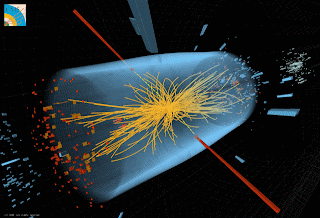While we are coming to the end of this year, there were lots of rumors on Higgs last week. Today at CERN the two big experiment CMS and ATLAS which are explicitly designed to discover the so-called Higgs particle announced the last finding of Higgs.
Both experiments found some excess in $115-130 GeV/c^2$ (ATLAS $115-130GeV/c^2$, CMS $115-127GeV/c^2$) and that could be due to Higgs boson decay. The experimental scientists at CERN carefully analyzed the all known decays of all known particles, then did some Monte Carlo simulations for a particle behaves like Higgs and compared the results. Indeed there is excess both in ATLAS and CMS more importantly in a few different decay channels those channels have quite different backgrounds so seeing that excess is quite significant. If Higgs really exist and its mass is in that region today could be one of the days that will be remembered and mentioned in popular science physics textbooks.
But in human history there are many false discovery claims, surely it could be false, and in time when we get enough data, the excess could be just a statistical fluctuation. In 2012 the LHC will continue to deliver proton beams and both experiments will continue to gather the data from the debris of proton collisions, possibly at the end of 2012 the data will be at least two folded and then we could certainly falsify the Higgs or celebrate the discovery.
Here you can find the famous excess both in CMS and ATLAS. I also attached statements and the presentations below.
 |
| In CMS a total of $~4.6fb^{-1}$ data is analyzed. |
 |
| In ATLAS in total up to $~4.9fb^{-1}$ data is analyzed. |
Scientist to find out whether an excess of the data is indeed a particle or just statistical fluctuations they use statistical techniques. So to claim a discovery, they use a parameter called $sigma$. Let me try to explain simply what the particle physicists mean when they say "we observed an excess with $sigma$ equals to something."
The CMS StatementIf Newton were sitting under his apple tree and making observations of falling apples, so he can claim the discovery of gravitation, and made 100 observations of falling apples and hitting him in the head and only ONE instance of those falling apples didn't hit him in the head, it is called $\sigma=2.5$. At $\sigma=3$ apples fell and didn't hit Newton in one out of every 370 times. That is not a scientific discovery either. If you observe the falling apples for a more than million times and only one of the apple doesn't hit in the head then we say $\sigma=5$. THAT is what we call a SCIENTIFIC DISCOVERY.
You may also check these links where you could watch the presentations held by ATLAS and CMS Spokesperson,



